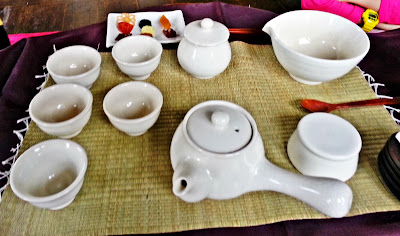After we had some breads and milk for breakfast in our room, we gathered again around 9 am. We didn't reserve for breakfast, as we usually have light breakfast. They insisted us to have breakfast as Seongyojang because they'd prepared Seongpyeon that we made yesterday and Chodang Sundubu (초당순두부) for us.
Wow! We're a bit shocked to see our breakfast spread!
We're quite disappointed as we didn't eat Chodang Sundubu yesterday. It's the specialty food in Gangneung. It's to our surprised that we could taste this original Chodang Sundubu (watery tofu made from locally grown soybeans and seawater, and is prepared and eaten within the same day) in Seongyojang. Therefore, although our tummy still full, we tried to clear most of the food with thankful heart.
~*~*~*~
Traditional Korean Tea Ceremony
OMG! Never imagined that we could step our feet in this beautiful and quaint Hwallaejeong Pavilion (활래정) to experience 'Dado' - the etiquette and enjoyment of tea in an easy, formal and natural setting.

Dado (다도체험) - Korean Tea Ceremony
The sound of the hot water as it is carefully poured, the sight of varyingly clear
and colored liquids filling empty cups, inhaling the unique and delicate fragrance of the tea,
the hands that extend with poise to slow sip the tea lightly and rolled over the tongue
while savouring and appreciate the aromas to the taster’s lips that appeals to all five senses.
You know after learnt Dado, I was so tempted to buy a set of teaware (차기 = chagi) to practice this art of preparing and enjoying tea in this delicate and cultured way. Please check this website for the procedure of the Korean Tea Ceremony and video guide ^^
Tea is said to be an aid to digestion after a meal and some claim it helps the complexion as well. It has no calories and is much lower in caffeine than coffee. Drinking green tea should be a calming experience that brings peace to your soul, and calms your nerves while allowing you time to think, dream or simply enjoy the fragrance and taste of the tea.
after filming ended enjoying drinking tea and eating Dasik (tea food),
while gazing the beautiful Lotus Pond. Please let the time stop there~!
Dasik (다식= Korean traditional sweet and cookies) is appreciated for its artistic and decorative colors and patterns as well as for its pleasing sweet taste. It is regarded as a healthful snack and classy dessert
The Teacher (선생님 = Seonsaengnim) explained to us about the philosophy of Korean food with yin-yang concept. It interacts and opposes itself in terms of its five flavours (Sour, Bitter, Salty, Spicy and Sweet), and also ingredients of five colours (Yellow, Black, White, Red and Green). Example: Sesame tastes bitter and it's benefited for brain development and stimulating function.
~*~*~*~
Traditional Korean Game - Yutnori (윷놀이)
Let's play Yutnori (video link)
After tea ceremony, we supposed to go outside to play Yutnori, but it was drizzling. So, they arranged it to the next room inside this Pavilion.
Yut game is quite simple, but there are some special rules and you need some strategies to win the game. Please check the link for the instruction and you can try to throw yut stick from iBuzzKorea. Well, it's kinda interesting and fun that these two kiddos didn't want to stop playing, but after third rounds we had to stop as we're rushing back to Seoul.
We went back to our room to get the luggage, and met Director of Seongyojang to say thank you for the great hospitality given to our family during our stay. It was a great honour that SBS and KTO given our family this memorable and priceless chance to experience Korean Traditional Culture in Seongyojang.
For those interested to learn more about Dado or other Korean traditional cultural experiences, please check Seongyojang's website for more information.
Seongyojang must be very scenic in Winter with white snow blanketing it~! Annyeong...
Related Posts:




